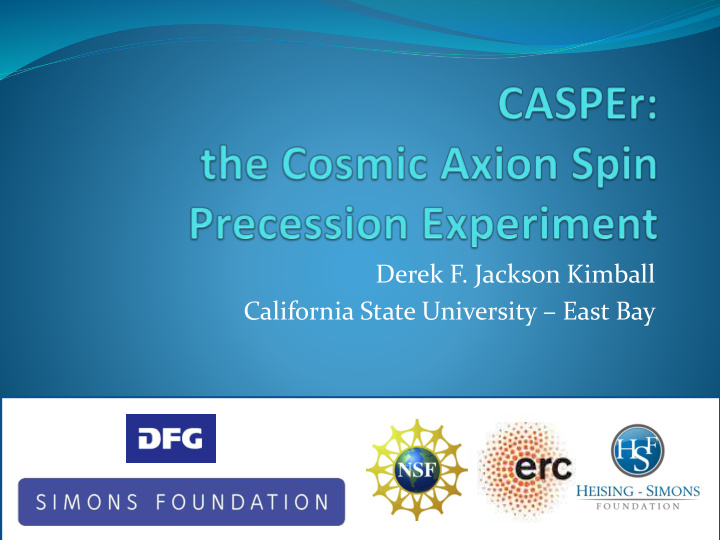



Derek F. Jackson Kimball California State University – East Bay
Collaboration
Collaboration
Collaboration Dmitry Budker, Arne Wickenbrock, John Blanchard, Samer Afach, Marina Gil Sendra, Martin Engler, Gary Centers, Nataniel Figueroa (Mainz)
Collaboration
Collaboration
Collaboration Surjeet Rajendran, Tao Wang, Dmitry Budker (UCB), Peter Graham (Stanford), Derek Kimball (CSUEB)
Collaboration
Collaboration
Collaboration Alex Sushkov, Deniz Aybas (Boston University)
Collaboration Alex Sushkov, Deniz Aybas (Boston University)
Outline Motivation and theory; CASPEr Electric; CASPEr Wind; New idea: a precessing ferromagnetic needle; Conclusions.
C osmic A xion S pin P recession E xpe r iment (CASPEr) Cosmic Axion Spin Precession Experiment
D. Budker et al., Phys. Rev. X 4 , 021030 (2014).
Axions Axions and axion-like particles (ALPs) are pseudo-Goldstone bosons of global symmetries broken at an energy scale f a .
Axions: misalignment When axions are produced after the Big Bang upon the breaking of the global symmetry, they are initially massless and can take on any initial field value a 0 .
Axions: misalignment However, when non-perturbative effects due to, for example, QCD become important, a potential develops for the axion.
Axion mass The QCD axion mass is given by: QCD ~ 200 MeV is the QCD confinement scale. ALPs may have different and f .
Axion oscillations Because of the random misalignment between the axion field a 0 and the potential minimum, the axion field oscillates at the Compton frequency.
Inflation and axion cosmology If the initial misalignment angle 1 in the early universe, then for the QCD axion: The “ anthropic ” window. However, if the inflation scale is lower than f a the universe before inflation can have an inhomogeneous distribution of a 0 . Any local patch can inflate into our visible universe with a uniform value of a 0 , and, of course, our visible universe has a dark matter density small enough to avoid overclosure.
Inflation and axion cosmology CASPEr Astrophysical ADMX constraints GUT scale Planck scale
Axion couplings Coupling to electromagnetic field Coupling to gluon field CASPEr Electric Coupling to fermions CASPEr Wind
Axion-induced electric dipole moments (EDMs) Nuclear EDM from the strong interaction (strong CP problem): Nuclear EDM from axion field: Can be thought of as an oscillating QCD .
Axion oscillation frequency Determined by the axion mass, related to the global symmetry breaking scale f a : f a at GUT scale MHz frequencies, f a at Planck scale kHz frequencies.
Axion-induced oscillating EDM Assuming axions are the dark matter, the dark matter density fixes the ratio a 0 / f a : This generates an oscillating EDM:
Nuclear Magnetic Resonance (NMR) NMR resonant spin flip when Larmor frequency
EDM coupling to axion plays role of oscillating transverse magnetic field SQUID pickup loop Larmor frequency = axion Compton frequency ➔ resonant enhancement.
Signal estimate n = atomic density; p = nuclear polarization; = magnetic moment; E * = effective electric field; S = Schiff suppression; L = Larmor frequency.
Sample choice Need maximum n , p , E * , and S , and long T 2 . For the first generation CASPEr-Electric experiment, we plan to use a ferroelectric crystal, likely PbTiO 3 .
Experimental strategy (1) Thermally polarize spins in a cryogenic environment at high magnetic field (~ 10 T); (2) Scan magnetic field down from 10 T -- Larmor frequency decreases from ~ 50 MHz; (3) Integrate for ~ 10 ms at each frequency, complete scan takes around 1000 s T 1 to complete.
Experiments beginning!
Experiments beginning!
Challenges (1) T 1 acquires field dependence due to paramagnetic impurities – long T 1 at high fields, short T 1 at low fields: this is a problem for duty cycle and maintaining polarization at low fields. (2) The chemical shift anisotropy (CSA) can broaden the resonance. (3) Vibrations can be an issue for low frequencies/fields. • Estimates of thermal drifts and magnetic field fluctuations indicate that they shouldn’t be a major problem.
Experimental strategy Experimental sensitivity
Phase 2 requirements (1) Longer coherence time: T 2 1 s. (2) Hyperpolarization: p 1. (3) Larger sample size: V 100-1000 cm 3 . R&D required!
Axion/ALP-induced spin precession (axion wind) Nonrelativistic limit of the axion-fermion coupling yields a Hamiltonian:
Axion wind detection SQUID pickup loop axion “wind” Larmor frequency = axion Compton frequency ➔ resonant enhancement.
Sample choice: liquid Xenon Relatively large sample can be hyperpolarized. The enhancement factor can be on the order of 10 6 .
Experimental setup
Experiments beginning!
Experimental sensitivity
D. F. Jackson Kimball, A. O. Sushkov, and D. Budker, Phys. Rev. Lett. 116 , 190801 (2016).
Ferromagnetic needles Why do compass needles orient themselves along the ambient magnetic field, while atomic and nuclear spins precess about the field?
Ferromagnetic needles Why do compass needles orient themselves along the ambient magnetic field, while atomic and nuclear spins precess about the field?
Two regimes: tipping & precessing
Threshold for precession
Threshold for precession
Idealized experiment
Magnetic field measurement
Sensitivity
What about the Uncertainty Principle?
What about the Uncertainty Principle?
Averaging away the uncertainty?
Averaging away the uncertainty?
Fluctuation-dissipation
Spectral density of quantum fluctuations Quantum fluctuations are spread over a broad frequency band: ( S ) 2 / f integration acts as a low-pass filter f
(Needle floating in cryogenic vacuum, T 0.1K.)
Noise • Magnons, • Phonons, • Thermal currents (Johnson-Nyquist noise), • Collisions with residual gas molecules, • Black-body radiation.
Suspension? Seemingly cannot use light or mechanical support to reach ultimate sensitivity… still thinking…
New searches for oscillating moments induced by coherent oscillations of the axion/ALP field offer the possibility to investigate a significant fraction of unexplored parameter space! If research and development of new samples and new hyperpolarization techniques succeed, we may be able to search for the QCD axion with f a near the GUT and Planck scale! New sensors based on precessing ferromagnetic needles could open new possibilities for precision measurements.
Recommend
More recommend